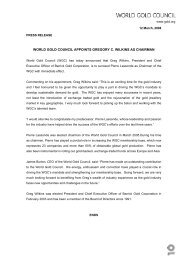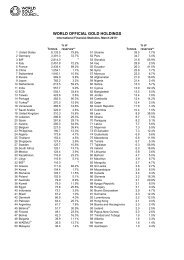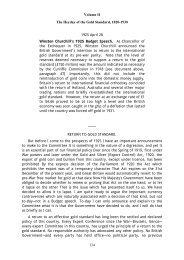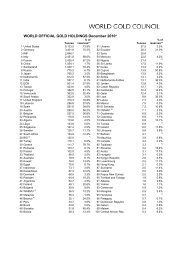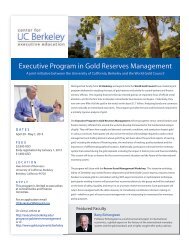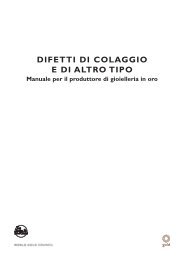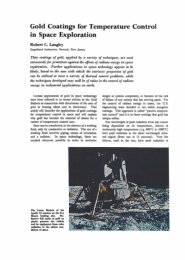Gold Derivatives: Gold Derivatives: - World Gold Council
Gold Derivatives: Gold Derivatives: - World Gold Council
Gold Derivatives: Gold Derivatives: - World Gold Council
You also want an ePaper? Increase the reach of your titles
YUMPU automatically turns print PDFs into web optimized ePapers that Google loves.
1.2 The role of storage<br />
So far we have ignored the role of storage; the model presented applies most<br />
naturally to the production of an agricultural commodity where there are two<br />
periods – a time for investment and a time for consumption. But for commodities<br />
like gold which are extracted rather than grown, and which can be stored if not<br />
consumed, more sophisticated analysis is required.<br />
Note that the existence of a forward market is equivalent to the existence of a<br />
commodity lending market. If the forward market exists, a synthetic commodity<br />
loan can be constructed by a spot sale and forward repurchase. Conversely, if a<br />
lending market exists, a forward sale can be synthesised by a spot sale coupled<br />
with borrowing the commodity. There may be some institutional differences between<br />
the contract and its synthetic equivalent, but these are small relative to the<br />
similarities, and at this stage of the analysis we can ignore them. For the present<br />
then in discussing the impact of a forward market, I include commodity lending<br />
markets as well as standard forward markets.<br />
The equivalence between forwards and commodity lending also means that the<br />
prices in the two markets are tied to each other. Assuming a standardised commodity,<br />
and ignoring taxation, credit and other similar issues, the cost of borrowing<br />
a commodity, expressed as an annually compounded rate b for a time of length<br />
T must be related to the spot price today S 0<br />
, the forward price today for delivery<br />
at T denoted by F 0,T<br />
, and the riskless rate of interest r (also continuously compounded)<br />
by the formula:<br />
F<br />
0, T<br />
= S e<br />
( r−b)T<br />
0<br />
Note that, in this definition, the person borrowing the commodity also bears the<br />
cost of storage, insurance and so on.<br />
If there is a forward or a commodity lending market, and if individual agents are<br />
too small to influence the market, people holding inventory presumably believe<br />
that they are getting some benefit from holding stocks which equals or exceeds<br />
the borrowing cost. Otherwise they would be better off lending the commodity<br />
to someone else. Now the benefits from holding stocks include the savings when<br />
there is breakdown in logistics, a surge in demand or a sudden spike in the price.<br />
It is reasonable to assume that there will be a strong link between the size of these<br />
benefits at the margin and the level of stocks held. If the level of stocks is very low,<br />
a small hiatus in supplies could cause disruption, so the marginal value of inventory<br />
is high. Conversely when stock levels are high, even a large and improbable<br />
shock may have little impact, so the marginal value of inventory will be low, and<br />
commodity borrowing rates will also be low.<br />
<strong>Gold</strong> <strong>Derivatives</strong>: The market impact 91



